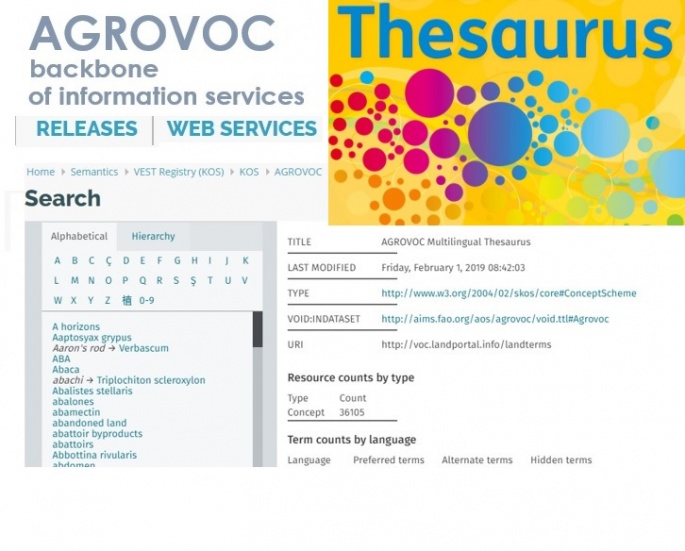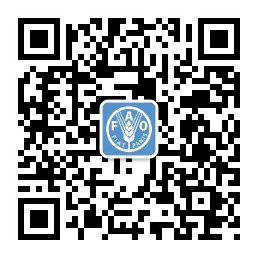Discover AGROVOC multilingual Thesaurus of the Food and Agriculture Organization of the UN (FAO)... in Numbers!


1980...
1980: AGROVOC multilingual thesaurus was started by FAO, in order to provide access to semantic information (concepts, terms, and relations) covering all of FAO's areas of interest including food, nutrition, agriculture, fisheries, forestry, environment and other related topics. |
To date, AGROVOC is a collaborative international effort, coordinated by FAO, with up to 30 editors from all over the world contributing (active in the area of agriculture and related sectors) to the expansion of the...
... AGROVOC KNOWLEDGE BASE :
- 36,105 concepts, as at February 2019 (up from 34,576 one year ago)
- 687,227 terms, as at February 2019 (up from 660,348 one year ago)
- 33 languages
2010...
Since 2010, AGROVOC has been expressed as a Semantic Web concept scheme using Simple Knowledge Organization System (SKOS). For the past decade, the technical e-infrastructure for AGROVOC has been managed in collaboration with FAO by the Artificial Intelligence Research group, in Tor Vergata University (Rome). AGROVOC content editing is now in VocBench3 (VB3) - an advanced collaboration web environment for maintaining thesauri, ontologies, code lists and authority resources, providing features such as history, validation, a publication workflow, and multi-user management with role-based access control. VB3 supports the multischeme hierarchy approach, i.e. the use of hierarchical relation properties specific to a scheme. VB3 allows that AGROVOC hierarchy is viewed flexibly and edited with its customized relations, or exported with a generic SKOS hierarchy of broader and narrower relations, without changing the hierarchy of AGROVOC itself. |
2017...
Being updated on a monthly basis (monthly since April 2017; see AGROVOC releases) AGROVOC is the most:
- used thesaurus in agriculture and related sciences in the world;
- popular to index and tag information resources in low-income countries.
Browse/Search AGROVOC in a web-based browsing environment SKOSMOS and check which AGROVOC terms/concepts could already be of use and relevant to Your work! |
AGROVOC is USED:
- to index electronic information resources, e.g. in specialized libraries as well as digital libraries and repositories;
- for text mining and to tag content in websites, e.g. integrating AGROVOC as a taxonomy of Typo 3 or Drupal;
- to facilitate search engine discovery;
- as a reference for translations;
- to linking datasets and enhancing access to open data;
- as a reliable source for standardization of agricultural information data and services
AGROVOC USERS:
Worldwide: CGSpace Repository, International Crops Research Institute for the Semi-Arid Tropics (ICRISAT), International Maize and Wheat Improvement Center (CIMMYT), International Food Policy Research Institute (IFPRI), National Bibliography on Tropical Biology (BINABITROP; search among these public databases), among others.
FAO: AGRIS, AGORA, AIMS.FAO.ORG, GODAN Action…, the FAO Website, FAO Country Profiles, FAO Corporate Document Repository, FAO Library Catalog, FAOTERM, FAOLEX database, among others.
AGROVOC in USE... in NUMBERS:
- 8,000,000 yearly visits to its knowledge base;
- 3,650,000 yearly access to AGROVOC search;
- 500,000 accesses to AGROVOC Webservices
- Reciprocal links (visible in the Linked Open Data Cloud) to other 18 other multilingual knowledge organization systems (vocabularies, thesauri). AGROVOC is available for re-use as a Linked Open Data under the international CC-BY IGO 3.0. license.
If you ever need to SUGGEST a NEW CONCEPT/TERM and are not an AGROVOC Editor:
Please send the suggested new concept in English, with any translations available, suggested broader term if possible, and the definition with source (the more information, the better!) to [email protected]. >> AGROVOC Editorial Guidelines may be helpful |
AGROVOC is indexed in the following registries:
- FAIRSharing service
- AgroPortal: an ontology portal
- Basel Register of Thesauri, Ontologies & Classifications
- VEST/AgroPortal online map or Agrisemantics Map of (~400) Data Standards [Have you already used this Map of Standards? You are cordially invited to help us improve this map – please complete our 2min survey here; thank you!],
just to name a few...
AGROVOC-RELATED... You are invited to take a look at:
- AGROVOC Thesaurus : a BACKBONE to INTEGRATE & DISCOVER interoperable DATA
- Did you know that AGORA has now 46 New Subject Categories from the AGROVOC multilingual thesaurus?
- Achievements, impact and strategy for AGROVOC’s future
- Discover open Land Linked Datasets shared by the Land Portal
- Using KOS as the Connectors of Linked Datasets
If you would like to share and/or need to obtain more information about AGROVOC use-cases, just contact us at [email protected] and /or Join AGROVOC mailing list |
To keep up-to-date with AIMS news, please, Sign up for AIMS news, follow @AIMS_Community on Twitter. And, thanks again for your interest!

